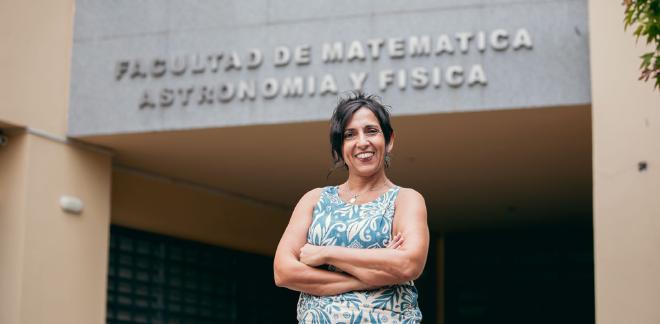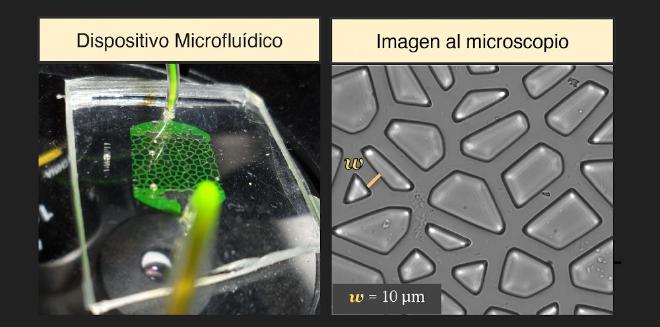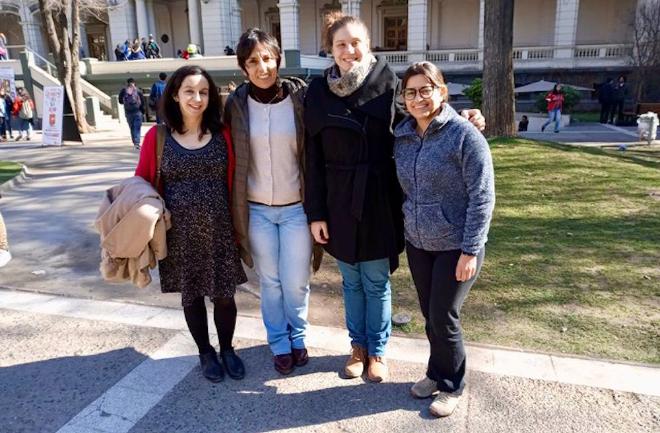

Bacteria move. They “swim” among the tiny grains of soil. Studying this mobility can help improve biofertilizers for economically important crops like soybeans and peanuts. However, for scientists, it has always been complex to investigate this in the laboratory.
Until scientists from the National University of Córdoba, in cooperation with colleagues from the National University of La Plata and Chile, created a microchip with microscopic channels that mimic the pores of the soil.
Thanks to this device, which fits on the tip of a finger, they made an important discovery that was published in one of the journals of the Nature publishing group in April 2025.
What did they discover? #
Some plants need bacteria to fix atmospheric nitrogen and grow better. But how do bacteria and plant roots come together and unite to produce this symbiosis?
That is where the microchip designed by researchers and students from the Faculty of Mathematics, Astronomy, Physics, and Computing (Famaf) of the UNC comes into play.
Thanks to this device, they discovered that the bacteria Bradyrhizobium diazoefficiens, which have two flagellar systems (a kind of arms/tails for “swimming”), do not necessarily move better than those with a single mobility system when confined in the smaller pores formed in soils.
“It was believed that the lateral flagella helped to swim in narrow spaces. But we saw that they do not: under confinement, they swim just like the others with a single rear flagellum. Perhaps those flagella serve another purpose, such as crawling when the ground dries up,” said Verónica I. Marconi, professor and researcher at Famaf and Conicet, within the Enrique Gaviola Institute of Physics (IFEG).
And she added: “This is a small step, but it is an important result that can open many doors to continue. Researchers at the National University of La Plata (UNLP) have been studying these bacteria for 30 years, and it is the first time they can see them like this in action.”
From basic science to applied science #
Marconi is an expert in microfluidics, an area of Physics that has generated significant advances in biology and medicine in recent years. It studies the behavior of fluids in tiny volumes, where liquids and gases behave differently than when we use a hose to water or want to fill the CNG tube.
The researcher has been working on basic aspects of this area for years. During a trip to Chile, she saw her colleague María Luisa Cordero working on a device similar to the one she created. “That looks like a floor!” she said, and that is where this more applied development began.
Each microchip is smaller than the tip of a finger and is transparent. Inside, it has channels that mimic different soil porosities. The channels can be less than a tenth of the thickness of a hair, that is, 10 microns. Soil bacteria measure one micron (1/100 the thickness of a hair).
An example of how differently fluids behave at this scale: it takes hours to carefully fill the tiny channels of the microchip with a suspension of bacteria. Once filled, a microscope can be used to see live how the bacteria move. Special software, developed at Famaf, the biotracker, allows tracking the movements of the microorganisms.

“Never before anyone had tracked the movement of these microconfined bacteria in such a way. What existed was trial and error: they would put bacteria in a tube and analyze how many moved from one side to the other. It was a black box,” Marconi said.
Anibal Lodeiro, a researcher at the Institute of Biotechnology and Molecular Biology (National University of La Plata and Conicet) and also an author of the scientific publication, asserts that a better understanding of the mobility of bacteria in the soil can guide two key aspects: the composition of the growth media in which the bacteria are cultivated and how to apply the inoculant in the crops.
“The way bacteria are inoculated determines how far they will have to move in the soil to reach the roots. We observed that inoculation in the planting furrow is more favorable than inoculation on the seeds, but a furrow inoculation technology must be developed, the cost of which should not exceed that of seed inoculation,” he explained.
Priority in training more scientists #
Therefore, their designs are available to the global scientific community and have been published in journals such as Communications Biology or Physics of Fluids.
In addition to its application for sustainable agronomy, Marconi and his team have developed technologies to study microfluidics in other areas such as sperm selection for assisted reproduction, with the work of doctoral students Marina Palacio, Matías Bettera, and Iván Berdakin.
Her team also developed proprietary software to track very small bacteria that existing programs could not detect. They are researching microgels and drug delivery. Several companies have already requested this service. Young undergraduate thesis students like Ian Roldan García** and Tobías Loggia are participating in these projects.
The team that developed the microchip was mostly made up of women and led by women. Marconi wants to emphasize this fact, especially considering the effort since a good part of the research was carried out while three of them were pregnant.

Meanwhile, Lodeiro acknowledges the challenges of interdisciplinary and inter-institutional work. “The problems of the natural environment are not restricted to a single discipline, therefore they always require the participation of diverse specialists. However, this approach is more difficult as it is necessary to integrate the languages and working methods of the different disciplines,” he explained.
Finally, Marconi reflected: “It is important to show that public universities can achieve this type of development. This came about through years of collaborative effort among colleagues, fellows, travel, grants from UNC, Conicet, Foncyt, and it generated the training of many human resources and knowledge that can directly improve local production.”
Citation #
-
Soil-mimicking microfluidic devices reveal restricted flagellar motility of Bradyrhizobium diazoefficiens under microconfinement. was published in Communications Biology from Nature group. Authors: Nahuel Gutiérrez, Sofía Montagna & Verónica I. Marconi (Famaf), from UNC. Moniellen Pires Monteiro, Juan Pablo Carrillo-Mora, and María Luisa Cordero (University of Chile). Aníbal Lodeiro (National University of La Plata).
-
The article Investigadores de la UNC crean un microchip para ver cómo «nadan» las bacterias del suelo, signed by Lucas Viano from UNCiencia Secretaría de Ciencia y Tecnología – UNC was published in UNCiencia’s website.

